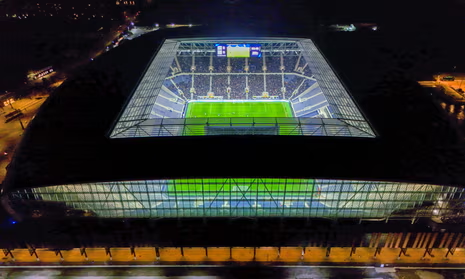The long-awaited opening of Everton Stadium has finally arrived, marking a significant milestone in the club’s history. Located on the banks of the River Mersey, the stadium has risen from the ashes of the neglected Bramley-Moore dock, which was once an abandoned and forgotten body of water. The dock, which had been dormant for many years, was home to twelve unexploded anti-aircraft shells from World War II, a sobering reminder of the site’s troubled past. However, under the ownership of Farhad Moshiri, Everton has been able to transform this abandoned site into a state-of-the-art stadium, one that promises to be a beacon of hope for the city of Liverpool and its people.

The journey to get to this point has been nothing short of arduous, with Everton having to navigate through two failed stadium projects at King’s Dock and Kirkby, as well as a proposal that never got off the ground at Walton Hall Park. However, with Moshiri’s vision and investment, the club has been able to bring its dreams to fruition. The £750m-£800m project has not been without its challenges, with the club having to overcome numerous obstacles and setbacks along the way. Nevertheless, the end result is a stadium that is not only a testament to the club’s determination but also a symbol of the city’s resilience and ability to adapt to change.
The stadium itself is a marvel of modern architecture, with a design that is both futuristic and striking. The steep bank of 14,000 seats in the South Stand, which will serve as the home end, offers breathtaking views of the city skyline, with no obstructions to spoil the vista. The facilities within the stadium are equally impressive, with vast concourses, refreshment kiosks, and toilets that are a far cry from the cramped and outdated amenities of Goodison Park, the club’s current home.
The opening of the stadium was marked with a friendly match between Everton’s and Wigan’s under-18 teams, with 10,000 lucky fans in attendance. The match, which ended in a 2-1 defeat for Everton, was a momentous occasion, with Demi Akarakiri kicking the first ball and Harrison Rimmer scoring the first goal at the new stadium. The event was a test run for the stadium, which will need to undergo two more test events before it can be used at full capacity.

The stadium’s potential impact on the city of Liverpool cannot be overstated. It is estimated that the stadium will attract 1.4 million visitors to the city annually, creating 15,000 jobs and generating £1.3bn for the UK economy over its lifetime. The stadium is expected to be a catalyst for the regeneration of north Liverpool, an area that has long been in need of investment and revitalization.
However, the opening of the stadium has not been without its challenges. The city council’s decision to impose year-round parking restrictions within a 30-minute walk of the stadium has sparked outrage among local businesses and residents, who claim that they were not consulted on the matter. The restrictions, which came into effect on Monday and are scheduled to last 18 months, have led to a petition being launched, with over 7,000 people calling on the council to scrap the restrictions.
Furthermore, the local authority’s transportation plans for the stadium have been criticized, with many fans and residents expressing concerns about the lack of adequate parking and public transportation options. The unveiling of a new fanzone at nearby Sandhills train station, which was widely ridiculed for its lack of amenities, has only added to the sense of frustration and discontent.
Despite these teething problems, Everton has played a significant role in ushering in a new era for the city and the club. The stadium is a testament to the club’s commitment to its fans and to the city of Liverpool, and it promises to be a source of pride and joy for generations to come. As the club looks to the future, it is clear that the sadness of leaving Goodison Park will be offset by the excitement and anticipation of playing at a state-of-the-art stadium that is worthy of the club’s history and tradition.

The preservation and restoration of heritage works at Bramley-Moore dock are a notable aspect of the stadium’s design. The original dock walls, which date back to the 19th century, have been preserved and now form part of the stadium’s foundation. The railway tracks that once carried coal to steamships on the Mersey have also been retained, and the Grade II-listed hydraulic tower, which was built in the late 19th century, has been restored to its former glory. The tower now forms a symbolic part of a 17,000-capacity outdoor plaza, which promises to be a popular spot for fans and visitors alike.
The infill of the dock, which took three months and 480,000 cubic meters of sand dredged from the Irish Sea, was a complex and challenging process. The dock had to be sealed, and two porpoises had to be guided out of the dock before it was filled with sand. The resulting stadium is a testament to the ingenuity and determination of the architects, engineers, and construction workers who worked tirelessly to bring the project to fruition.



